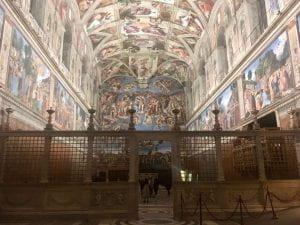Not to get dramatic here, but art is everything when it comes down to the pure romanticism of life itself.
I am studying abroad this semester in Florence, Italy under Syracuse University’s Florence program. I’m taking this class simply called “Michelangelo,” in which we trace the life and works of the Renaissance master Michelangelo throughout the 15th and 16th centuries. Of course, this story may be biased since I’m an art history major with an affinity for Renaissance art, but my point still stands.
Our class was given the special privilege of an overnight trip to Rome complete with a private tour of the Sistine Chapel. For anybody who doesn’t know, the Sistine Chapel was one of Michelangelo’s major projects, some may even argue his magnum opus. It is the utter transformation of a starry blue skied painting to nine scenes from the Book of Genesis from the Old Testament. Commissioned by Pope Julius II, Michelangelo spent four years working on the ceiling and then came back 25 years later to paint the altar wall, a scene of the Last Judgement.
Okay so, whatever. Spiel on the art history of the Sistine over.
An alumni of Syracuse Florence actually donates the private tour of the Sistine to the Michelangelo class each Fall semester. That is how I got to stand, with only 20 other people, at 7:30 p.m., in one of the most important sites to art history, to the Catholic church, to general global culture.
As I strained my neck staring directly up at the Creation of Adam, a cultural icon to the Western world, parodied and replicated by numerous artists, celebrities, writers and everyday people. Ariana Grande literally asserts herself into the position of God in this scene in her “God is a Woman” music video. The sheer impact of seeing the Creation in real life is indescribable. It’s even more baffling when I realized that my 20 other classmates are having the same feet-shaking, heart-pounding experience as me. We don’t speak to each other at all in this entire hour. We only gave each other wide-eyed glances once in a while, then immediately directed our attention back to the bright blue background of the Last Judgement, or the grand figure of the Delphic Sibyl. I’ve studied these figures in multiple classes now; most Western art history professors will somehow always come up with a way to compare Michelangelo to any art period in history. There is something special about being given the undeserved opportunity to view it, in almost solitude, in real life.
As I laid on the plastic covered benches that line the edges of the room, I was simultaneously feeling intense gratitude, slightly conflicted knowing the history of the Catholic Church, and sheer awe at the artistic brilliance it took to complete a project this large in just four years. Michelangelo painted the ceiling at a time of intense Papal Authority–which only means a time in history in which the church and state were absolutely intersected in their interests. He painted the ceiling under the scrutiny of Pope Julius II, and who was this mere artist to say no?
I feel extremely grateful to the world that I get to have this experience. Art is everything, but it is highly privileged, sometimes highly privatized, at times ableist, at times racist, sexist, or homophobic. Or a mixture of it all. Of course, we cannot win it all. The subjectivity of art provides no basis for a work that wouldn’t be controversial. But man, when it comes down to it, the beauty of art can be argued for why life is worth it.
To end this post, here’s a truism from the great character of John Keating from Dead Poets Society (1989), “We don’t read and write poetry because it’s cute. We read and write poetry because we are members of the human race. And the human race is filled with passion. And medicine, law, business, engineering, these are noble pursuits and necessary to sustain life. But poetry, beauty, romance, love, these are what we stay alive for.”


